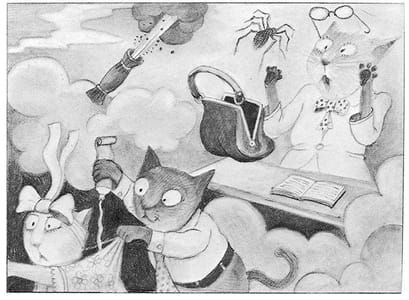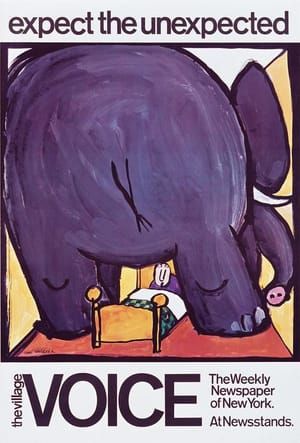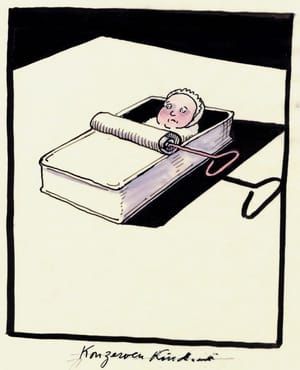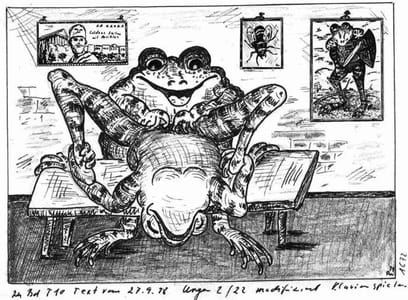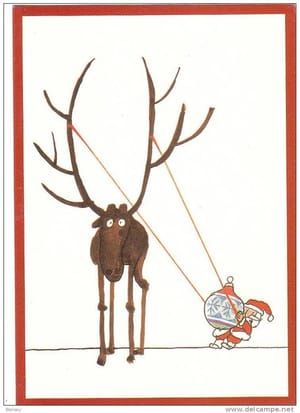
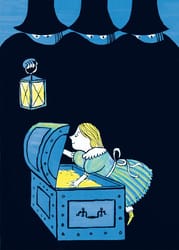
Illustration from The Three Robbers
Tomi Ungerer
The Three Robbers tells the story of three fierce black-clad robbers who terrorize and plunder the countryside, armed with a blunderbuss, a pepper blower, and a huge red axe…
The Three Robbers has been translated into 16 languages and has sold millions of copies in the 45 years since it was first published. The book was written and illustrated by the award winning childrens author Tomi Ungerer. Now re-published by Phaidon this childrens classic is once more available in English.
(http://www.tomiungerer.com/work/books/the-three-robbers/)
Q. You mentioned your dislike of captions, but you’ve always been a storyteller. How and why do you use language in your children’s books?
A. Well, this was a big fight in the old days. Still, to this day, the Americans say that you should use a vocabulary that the children already have and understand. And I say, No. Children should be given a challenge with new words. My wife and I read our children stories every night—but way ahead of their age. Why not read The Little House on the Prairie to a four-year-old child? I never had this problem with Ursula Nordstrom at Harper. She was the only one who didn’t give a shit about this. But when The Three Robbers came out, they wanted me to take out the word blunderbuss for the gun. But blunderbuss—isn’t that a beautiful word? My god! Blunderbuss!
(https://www.theparisreview.org/blog/2015/01/30/all-in-one-an-interview-with-tomi-ungerer/)
The Three Robbers is a children's book by Tomi Ungerer. The book was adapted as a full-length feature film by Hayo Freitag, released in mid-2007. There was also a 6-minute version released in 1972 by Gene Deitch.
(https://en.wikipedia.org/wiki/The_Three_Robbers)
The three robbers mentioned are exactly that — a dark band roaming the nighttime countryside. “The first had a blunderbuss,” Ungerer writes. “The second had a pepper-blower. And the third had a huge red ax.” Blunderbuss is pure Ungerer. It’s a word that is not afraid of its weaponliness. The robbers ax carriage wheels, terrify brave men. They hide their loot in a cave in the mountains — trunks and chests full of treasure. As one preschool teacher I know explains to her students (while they nod knowingly): “The robbers aren’t mean. They are just rude.”
The robbers come upon a carriage carrying a little girl, an orphan, who, because she is on her way to live with an evil aunt, feels fortunate to be plunder. The robbers take her back to their cave. When she wakes in the morning, she sees the treasure and asks, “What is all this for?” The robbers are dumbfounded, a joke that reads even better during a financial crisis. Resolution eventually comes as “all the lost, unhappy and abandoned children” are gathered up and brought to a castle, bought with treasure. “The children grew until they were old enough to marry.”
...His drawings show a love of the details of all these, rendered with a late- medieval lusciousness: the pepper sprayer is part musical instrument, part mining machinery, part toy.
(http://www.nytimes.com/2008/12/21/books/review/Sullivan-t.html)
Uploaded on Apr 22, 2017 by Suzan Hamer
Tomi Ungerer
artistArthur
Wait what?



